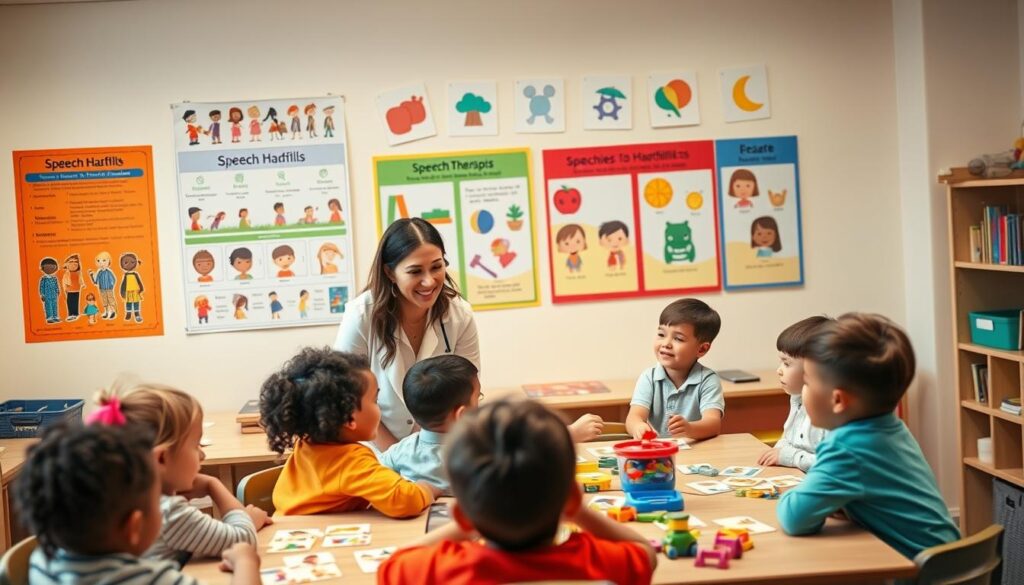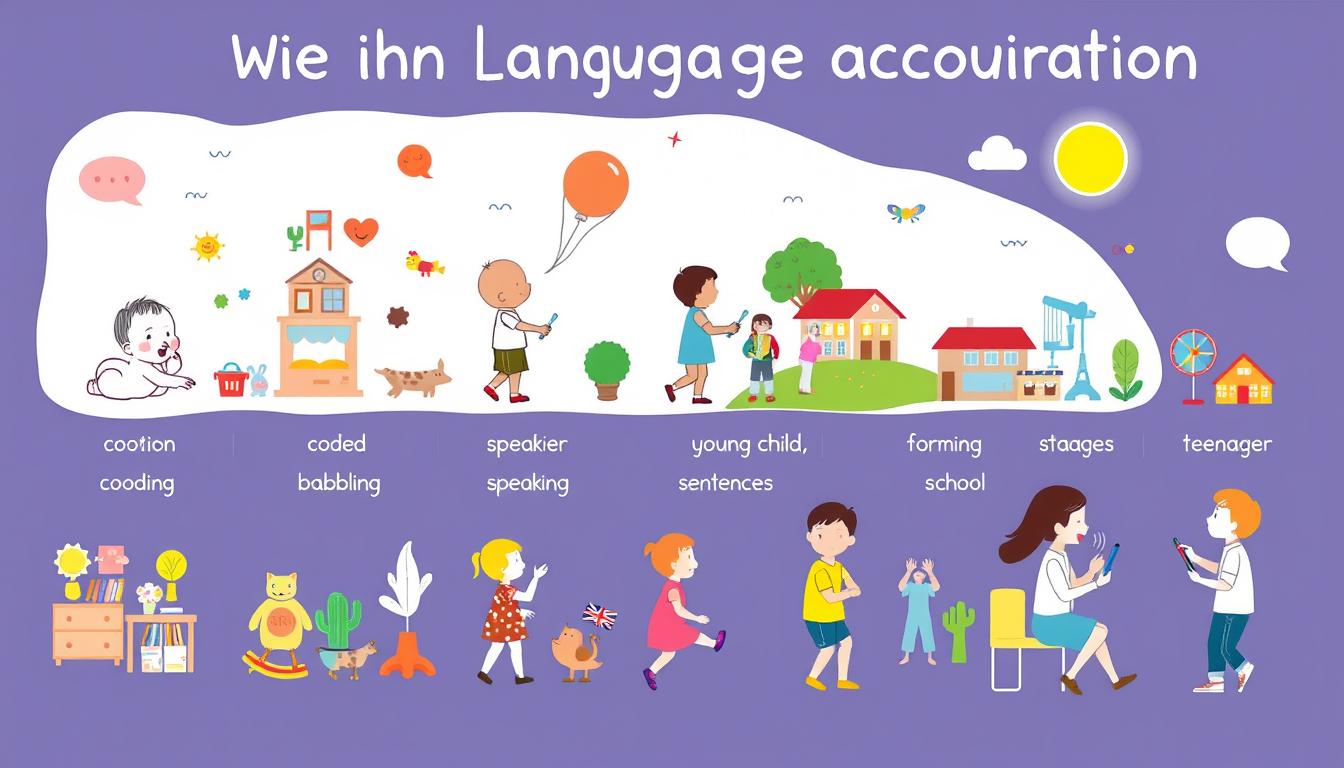Students move from kindergarten to 12th grade, and it’s key to check they hit speech and language milestones. This article will cover the main speech and language markers for each grade. It will also guide on when to think about speech therapy support.
Good speech and language skills are vital for a student’s success in school, social life, and happiness. Knowing what communication skills are expected at each grade helps teachers and parents spot delays early. They can then start targeted help to support students.
Key Takeaways
- Understand the speech and language milestones for students from kindergarten through 12th grade.
- Learn what to look for at each grade level to identify potential speech and language delays.
- Discover when to refer a student for speech therapy to support their developmental needs.
- Recognize the importance of early intervention for improving speech and language skills.
- Familiarize with the factors that influence language acquisition and development.
Understanding Speech and Language Development
Learning to speak and understand language is key for students. It helps them communicate well, do well in school, and make friends. Knowing how kids learn language and spotting delays is important for helping them early.
Importance of Early Intervention
Helping kids with speech and language issues early is crucial. Catching problems early lets kids keep up with their friends and learn to communicate better. This helps them do well in school and socially, and prevents bigger problems later.
Factors Influencing Language Acquisition
- Being around lots of language and involved parents helps kids learn language.
- How well kids think, pay attention, and process information affects their language skills.
- The way the brain develops can also play a part in how kids learn language.
Knowing these things helps teachers and caregivers support kids in learning language. They can spot speech delays or red flags for speech therapy referral early. This means they can start early intervention to help.
“The foundation of a child’s language development is laid in the first few years of life. Early intervention is crucial for addressing any speech or language challenges and ensuring a child’s successful academic and social journey.”
Speech Development Milestones
Children’s speech and language skills grow quickly as they get older. It’s important for parents, teachers, and healthcare workers to know what speech skills kids should have by certain ages. This helps spot speech delays early and get kids the help they need.
Articulation Skills by Age
Articulation is key to clear speech. It means making speech sounds correctly. Here’s what kids should be able to do at different ages:
- 2-3 years old: Kids this age can make most vowel sounds and simple consonants like “p,” “b,” “m,” and “n.” They might find sounds like “s,” “r,” and “th” hard.
- 3-4 years old: By now, kids should know most consonant sounds, except for “s,” “z,” “r,” “l,” “th,” and blends like “st” and “bl.”
- 4-5 years old: Most kids can make all consonant sounds by this age, even tricky ones like “s,” “z,” “r,” and “l.” But, they might still find blends and complex sounds hard.
- 5-6 years old: At this point, kids should be good at articulation, making all speech sounds right. They might still struggle with blends or words with more syllables, but their speech should be mostly clear.
Remember, these are just guidelines. Kids develop at their own pace. Knowing these milestones helps spot articulation skills by age and expressive language disorders early. This means they can get the speech therapy they need sooner.
Language Acquisition Stages
Knowing the stages of learning language is key to spotting speech and language issues in K-12 students. Kids move through milestones from understanding language to speaking it themselves. This journey is important for their growth.
At first, kids learn to understand language, like hearing and making sense of words and phrases. Then, they start to speak out, sharing their thoughts and needs.
The process of learning language can be broken down into several stages:
- Babbling and cooing (0-6 months)
- First words (6-12 months)
- Two-word phrases (12-24 months)
- Sentence formation (24-36 months)
- Increased vocabulary and complex grammar (3-5 years)
Keep in mind, every child learns at their own pace. If a child has trouble understanding language, they might need help early on.
| Language Acquisition Stage | Age Range | Typical Milestones |
|---|---|---|
| Babbling and Cooing | 0-6 months | Produces vowel-like sounds, coos, and babbles |
| First Words | 6-12 months | Understands and produces simple words like “mama” and “dada” |
| Two-word Phrases | 12-24 months | Combines two words to form simple sentences, such as “Daddy bye” |
| Sentence Formation | 24-36 months | Constructs longer, more complex sentences with basic grammar |
| Increased Vocabulary and Complex Grammar | 3-5 years | Rapidly expands vocabulary, uses varied sentence structures, and demonstrates more sophisticated language skills |
Knowing about language acquisition stages helps teachers and parents spot and help with receptive language difficulties. This support is crucial for students to do well in school and with friends.

Identifying Speech Delays
Spotting speech delays in students is key for their growth in school and social skills. Early detection lets us offer the right help and support. We need to know the signs that show a speech therapy check-up is needed.
Red Flags for Speech Therapy Referral
Some signs that might mean a speech therapy check-up is needed include:
- Difficulty with articulation, such as mispronouncing sounds or struggling to form words clearly
- Delayed language development, where the student’s vocabulary and sentence structure are behind their peers
- Fluency issues, such as frequent stuttering, hesitations, or repetitions while speaking
- Vocal challenges, including a hoarse, nasal, or breathy voice quality
These signs can show up at different times in a student’s growth. It’s vital to keep an eye on their progress. Quick action is key to fix the problems early and help the student do well in the long run.

By keeping a close watch and acting fast when we see red flags for speech therapy referral, teachers and parents can make sure students get the help they need. This way, students can overcome identifying speech delays and reach their full potential.
What to look for at each grade level and when to refer for speech therapy
As kids move up in school, watching their speech and language skills is key. Each grade has its own milestones for communication. Spotting delays or issues early can help get them the right help fast.
In kindergarten, kids should start speaking in simple sentences and following instructions. They should also chat back and forth with others. If they’re having trouble with these skills, speech therapy might be needed.
By elementary school, kids should be using more complex language and understanding stories or talks. If they’re struggling to read, find words, or share their thoughts, speech therapy could help.
- In middle school, students should be able to share their ideas and join in group talks. They should also get abstract concepts. If they’re having trouble with organizing their thoughts or using language clearly, speech therapy might be a good idea.
- High school students need to speak fluently and share their knowledge well. If they’re still struggling with words, complex texts, or clear speaking, an evaluation by a speech therapist could be helpful.
It’s important to keep an eye on speech and language skills at every grade. If you see any red flags, talk to your child’s teacher or a speech-language pathologist. They can tell you when speech therapy might be a good step.
| Grade Level | Communication Milestones | Referral Indicators |
|---|---|---|
| Kindergarten |
|
|
| Elementary School |
|
|
| Middle School |
|
|
| High School |
|
|
By keeping an eye on speech and language skills at each grade, we can spot issues early. This means we can get students the help they need to do well in school and with friends. Early action is key for their communication skills.
Evaluating Speech Intelligibility
Checking how well someone can be understood when they speak is key to spotting speech and language issues. This means looking at how well a student can communicate and be clear to others. Experts use special tools and methods to see how well a student speaks clearly, knows sounds, and makes their speech clear.
Expressive Language Disorders
Expressive language disorders make it hard for students to share their thoughts, ideas, and feelings in words. They might find it tough with words, grammar, and putting sentences together. By carefully checking, experts can find out where the student needs help. Then, they can make plans to improve how the student speaks.
Receptive Language Difficulties
Receptive language issues make it hard for students to understand what is being said. They might not follow directions well, get the meaning of words, or get complex sentences. Experts are key in checking how well students understand language. They create special plans to help students better understand and process language.
FAQ
What are the key speech and language milestones students should reach from kindergarten through 12th grade?
Why is early intervention for speech and language development so crucial?
What factors can influence a student’s language acquisition?
What are the key articulation skills students should develop at different age levels?
What are the stages of language acquisition, and how do they develop?
What are the common red flags that may indicate a need for speech therapy evaluation?
What should educators and parents look for at each grade level to determine if a student needs a speech therapy referral?
How is speech intelligibility evaluated, and what are the implications of expressive and receptive language disorders?





